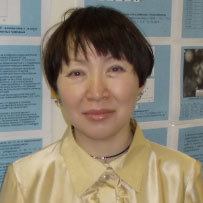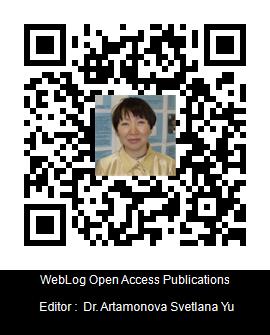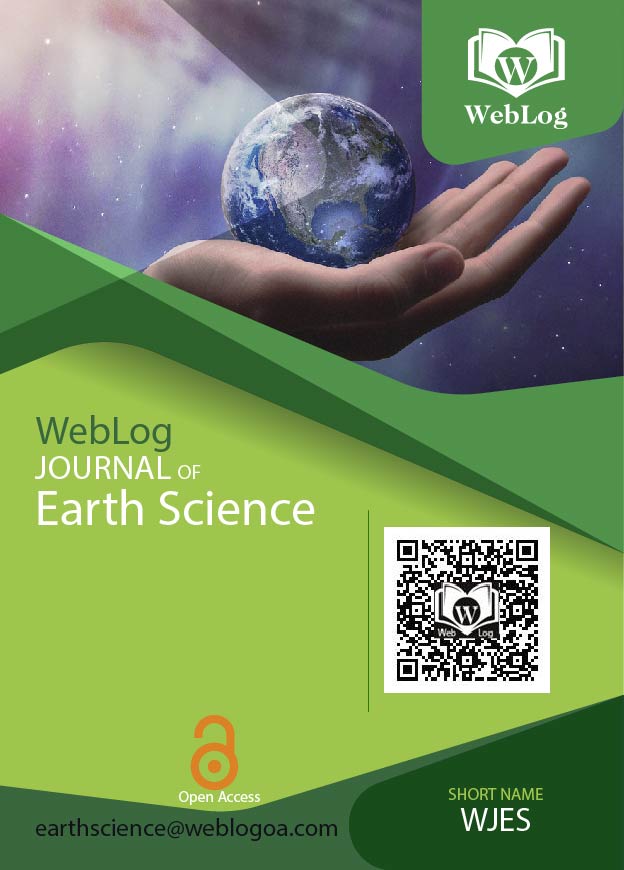Editor Profile

Dr. Artamonova Svetlana Yu
Senior Researcher
Present
V. S. Sobolev Institute of Geology and Mineralogy of the Siberian Branch of the RAS
Novosibirsk
Russian Federation

Artamonova Svetlana Yurievna was born in the vicinity of Borogontsu, of the Ust-Aldan municipal district of the Yakut Autonomous Soviet Socialist Republic in 1965. Artamonova S.Yu. graduated from the physical-mathematical specialized secondary school No.165 in Novosivirsk city in 1982. Artamonova S.Yu. graduated from the Department of Geology and Geophysics of the Novosibirsk State University in 1987 as a qualified geologist.
In 1987 S.Yu.Artamonova took up the research position at the Institute of Geology and Geophysics of the Siberian Branch of the Academy of Sciences of the USSR as a young starting researcher. Now Dr. S.Yu. Artamonova is Senior Researcher at this Institute, named V.S. Sobolev Institute of Geology and Mineralogy, Siberian Branch of the Russian Academy of Sciences.
The problem of the stratigraphical position and sedimentary conditions of icy-silty quaternary rocks of North Yakutia was considered in her graduate thesis. The scientific interests of Artamonova S.Yu. are connected with the problems of radioecogeochemistry and geoecology.
- Artamonova S. Yu. carried out scientific generalization of the scale and dynamics of changes in the geochemical background of natural radionuclides and toxic elements in the permafrost landscapes of the Southern Yakut gold ore region. Artamonova S.Yu. upheld In 2000 S.Yu. Artamonova was awarded the scientific degree of Candidate of Science (PhD) in Biology, in the speciality 11.00.11 - Environmental protection and sustainable nature management.
- Yu. Artamonova studies modern geoecological situation at the sites of peaceful underground nuclear explosions Crystall, Kraton-3, Kraton-4, Neva-1, Neva-2, Neva-3, Neva-4, Oka, Vyatka, Sheksna (performed during the years 1974 to 1987) in Yakutia. High-resolution g-spectrometric analysis with semiconductor detectors, radiochemical methods of sample preparation for a-spectrometric and b-radiometric analysis, liquid scintillation spectrometry, ICP-MS and geophysical sounding - transient electromagnetic method (TEM) survey were used in these studies.
Artamonova S.Yu. elucidated that 9 underground nuclear explosions were carried out in the region where underground pressure brines of the Siberian platform occur. With the help of TEM, anomalous subsurface sites of the uplift of underground brines by 260-300 m above the usual level of brines were revealed around the explosion cavities of Crystal and Kraton-3. This is the evidence that technogenically destroyed subsurface sites with high fluid permeability are still present in the interior. Under these conditions, the appearance of salty chloride water (as a rule, with mineralization above 1 g/l) on the surface was shown by Artamonova S.Yu., to be a simple indicator of the emergence of underground fluids, as distinct from local natural surface water – fresh water of hydrocarbonate or hydrocarbonate-sulfate composition.
S.Yu.Artamonova developed the conceptual geoecological model of geotechnogenic systems of underground nuclear explosions. It was revealed that the cavities of underground nuclear explosions are open, independently of the geological conditions, depth and mode (normal or emergency), and there is permanent mass and energy exchange in the system «cavity of underground nuclear explosion – surrounding geologic subsurface – earth’s surface». The indicators of radionuclide transport from explosion zones are: an increase in the activity of 3Н - 2-34 times, 90Sr – 2-16 times, 239+240Pu – 10-25 times above the regional background level; an increase in the concentrations of lanthanides Y, Co, Be several times in comparison with the local background level; a decrease in the isotope ratio 238U/235U to 126 (instead of the natural ratio which is equal to 138). Radionuclide transport proceeds through fluid-permeable geostructures: technogenic – 1) mechanically weakened cracky column zones around explosion holes; 2) old untight exploration wells; natural – 3) aquifers; 4) tectonic fractures, including those refreshed after underground nuclear explosions; 5) cracky contact zones of igneous rocks (trappean sheet, kimberlite pipes of Siberian craton). Each of these structures is characterized quantitatively by the geophysical and geochemical parameters (apparent resistivity of rocks, activities of technogenic radionuclides, content of elements and anions).
The obtained results laid the basis of the Thesis for the Doctor of Science degree prepared by Artamonova S.Yu., entitled Geotechnogenic systems of underground nuclear explosions in Yakutia (1974-1987): geoecological model and migration peculiarities of radionuclides and some elements. In 2015 S.Yu.Artamonova was awarded the scientific degree of Doctor of Earth Sciences (geology and mineralogy) in the speciality 25.00.36 «Geoecology».
The program of radioecological monitoring and GIS-database, made by Artamonova S.Yu., are used by the Ministry of Nature Protection of the Republic of Sakha (Yakutia) in their activities.
The aerosol technogenic pollution is the third area of the scientific interests of Artamonova S.Yu. Mineral and geochemical peculiarities of the technogenic aerosols accumulated in snow blanket during winter are studied by Artamonova S.Yu. over the territory of industrial cities in Siberia. The research is supported by the Russian Foundation for Basic Research under Project No. 09-05-00839 «Mineral-geochemical peculiarities of the technogenic aerosols of Siberia» (2009-2011) and Project No. 14-05-00289 «Element and mineral-phase composition of technogenic aerosol as methodological basis for the assessment of environmental pollution of urban and mining territories of Siberia » (2014-2016).
The X-ray fluorescence analyses on synchrotron radiation, ICP-MS, ICP-AES, X-ray diffractometry, scanning electron microscopy and other analytical methods are used in the studies. The pollution of the area of Siberian Chemical Plant (Seversk) and Novosibirsk Plant of Chemical Concentrates are studied. An increase in U, Th, REE content in aerosols, a decrease in Th/U ratio inaerosols to 1.6–1.9 are revealed to be the geochemical indicators of nuclear-fuel plant emission. A decrease in the isotope ratio 238U/235U to 77.43 in aerosols, compared to the natural value 137.9, is the isotope indicator of nuclear-fuel plant emission. Examination by means of scanning electron microscopy revealed the presence of the microparticles of uranium oxides with admixtures of Fe, Cu in aerosol of the area of Novosibirsk Chemical Concentrates Plant.
- Geoecology and Geochemistry of Radionuclides at the Underground Nuclear Explosions Sites
- TEM-sounding, Electrotomographic Study of Underground Nuclear Explosions Sites
- Air Pollution, Radionuclides in Aerosols
- Artamonova S.Yu. Uranium and Thorium in aerosol fallout of Novosibirsk city and its vicinity (West Siberia) // Bulletin of Tomsk Polytechnic University. Geo Assets Engineering, 2020. V.331, 7, pp. 212-223 https://doi.org/10.18799/24131830/2020/7/2731
- Artamonova S.Yu., Shein A.N., Potapov V.V., Kozhevnikov N.O., Novikova P.N., Ushnitskii V.E. Magnetic anomalies at the site of the peaceful underground nuclear explosion «Crystal» (Western Yakutia) // Bulletin of the Tomsk Polytechnic University. Geo Assets Engineering. 2020, V. 331, 12, pp. 158-172. DOI https://doi.org/10.18799/24131830/2020/12/2949
- Artamonova S., Shein A., Potapov V., Kozhevnikov N., Ushnitsky V. Shallow Permafrost at the Crystal Site of Peaceful Underground Nuclear Explosion (Yakutia, Russia): Evidence from Electrical Resistivity Tomography. Energies. 2022, 15, 301. https://doi.org/10.3390/en15010301
- Artamonova S.Yu, Bondareva L.G., Melgunov M.S., Simonova G.V. Modern Radioecological Situation at the Site of the Peaceful Underground Nuclear Explosion “Crystal” and Radionuclides in the Surface Waters of the Adjacent Territory (Western Yakutia)// Radiochemistry. 2023, V. 65, No. 5, pp. 599–617.

